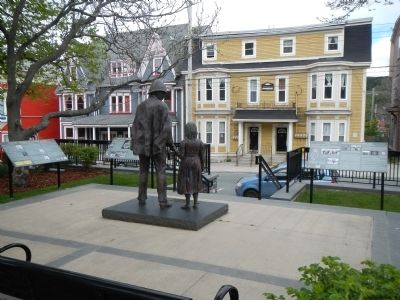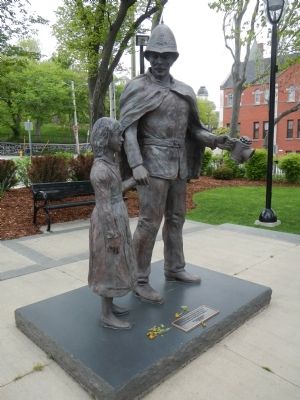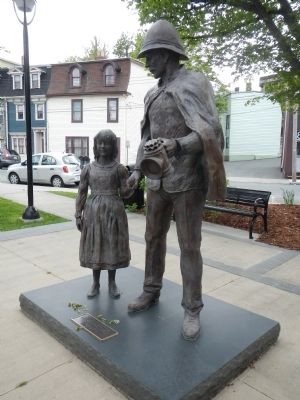St. John's in Avalon Peninsula, Newfoundland, Newfoundland and Labrador — The Atlantic Provinces (North America)
(Royal Newfoundland Constabulary Monument)
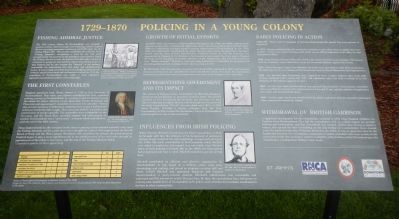
Photographed By Barry Swackhamer, June 22, 2014
1. 1729-1870 Policing in a Young Colony panel
Capitons: (top, left) People accused of capital crimes were sent to trial in England. Fishing Admirals in Newfoundland dealt with all sorts of other lesser crimes and whipping was a common form of punishment in the early 1700s.; (middle, left) Captain Henry Osborn served as Newfoundlandís first Governor in 129-1731.; (middle, center) Governor John Harvey served in Newfoundland in 1841-1846, and initiated a connection with the Irish Constabulary.; (bottom, center) Timothy Mitchell is regarded as the first chief of Newfoundlandís modern constabulary.
Panel 1:
Fishing Admiral Justice
The 15th century fishery off Newfoundland was primarily a summer activity with few people over-wintering; indeed, England did not encourage permanent settlement until 1699 under the “Act of King William III”. This act also established the authority of the “Fishing Admirals”, recognizing a need for law and order precipitated by the increase in the population each summer. Under the Fishing Admiral system, the master of the first ship to arrive at a harbour in spring not only has first choice of the fishing rooms in that harbour, but he also became the “Admiral” of the harbour, responsible for maintaining law and order and administering justice. It was a rough and ready system in a fledgling colony, but as workers stayed year-round and settlements evolved (in 1716 the population of Newfoundland was 3,295), a more organized approach was needed to achieve civile social order.
England appointed Capt. Henry Osborn in 1729 as first Governor of Newfoundland. That same year Osborn established the first organized policing system in Newfoundland, by creating 6 judicial districts across the island (St. Johnís, Harbour Grace, Bonavista, Trinity, Ferryland, and Placenita) and appointing 31 constables to oversee law and order. Osborn also served a local tax on fishermen, requiring them to pay a half quintal (A quintal is equal to 112 lbs or approx. 5kg) of fish per hundredweight caught. These proceeds paid for constables, and construction of stocks and jails. The constables were responsible to the Governor, and the Royal Navy provided support and enforcement as needed. Newfoundland was a “naval state”, a system which was effective until the end of the 18th century.
These improvements by the Governor in the colonyís policing system drained authority away from the Fishing Admirals, and for a time there was a struggle for control. With support from the British Board of Trade and the West Country Merchants who controlled the fishery, the government in England began to play a more significant role in the administration of law and order through its appointment of the colonyís Governors, and the role of the Fishing Admirals faded.
Sectarian strife was common in Newfoundland throughout the 1700s and 1800s, putting much pressure on the early constables and magistrates. Early Governors would send junior Royal
Navy Officiers to administer surrogate courts in remote coastal areas of Newfoundland. By the 1750s there were three courts operating in the colony; the Governorís Court, the Royal Navy Surrogate Courts, and the Court of Oyer and Terminer (Criminal Courts). In 1751 the Governor was empowered by England to try all felons in Newfoundland (previously, they were sent to England for trial), and if necessary, to execute offenders locally. Magistrates, who also had jurisdiction over “Master-Servant” infractions, were providing instructions to constables on procedures for executing police pursuit, making arrests and execution of writs.
By 1807 there were 34 constables. Governor John Duckworth, appointed in 1810, used revenues from tavern licenses to pay constables for dedicated, full-time duties. Over time, the constabulary became more self-reliant and its members more accepted as the keepers of law and order.
The advent of Representative Government in 1832 and subsequently electioneering precipitated an increased need for order. The British Garrison at Fort Townsend did its share, but Governor Sir John Harvey expanded his sights. Harvey, a former Inspector-General with the Irish Constabulary (“Royal” was not added until 1867), in 1844 hired Timothy Mitchell, a former colleague
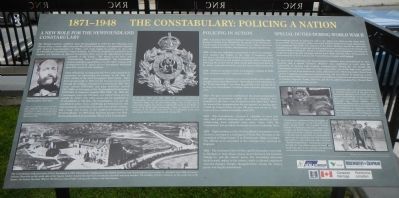
Photographed By Barry Swackhamer, June 22, 2014
3. 1871-1948 The Constabulary: Policing a Nation panel
Captions: (middle, left) Thomas Foley, Inspector & General Superintendent, 1871-1873.; (bottom, left) The Constabulary took possession of Fort Townsend in 1871 following the withdrawal of the British Garrison from Newfoundland a year earlier. In this photo circa 1890, the former Infantry Barracks on the north side of the Square (centre) housed the married Constabulary members and their families. The building with five chimneys on the south side of the Square , the former Garrison Officiersí Residence, housed high-ranking police officiers and their families.; (top, center) In the late 1800s and early 1900s the Constabulary Force of Newfoundland was also known as the Terra Nova Constabulary. This impressive badge was the pith helmet badge worn on duty and on ceremonial parades. Its design is undoubtedly based on the Badge of Merit of the Royal Irish Constabulary, which is identical with the exception of the words “Terra Nova”. It is emblematic of the close relationship that had been established with the RIC.; (middle, right) A Constabulary officier seen providing directions to American servicemen in the area of Fort Townsend. Beginning with a 1940 agreement between Newfoundland and the United States, there were thousands of American military personnel and civilian contract workers stationed at military bases and installations all over the island. In St. Johnís, the Americans built Fort Pepperrell, an impressive Army base to house a contingent of 5,500 servicemen. In 1961 the Americans vacated Fort Pepperrell, and the area reverted to is former name, Pleasantville.; (bottom, right) A Constabulary patrolman giving instructions to a group of servicemen in the east end of St. Johnís during WWII. The so-called “friendly invasion” of servicemen from the United States, Canada, and Britain placed considerable strain on the Constabularyís limited resources. Adding to the daily hustle and bustle of a garrisoned St. Johnís was the significant task of providing law and order to a city which was under war-time “Blackout Regulations”. Constabulary members, through the tremendous support of family and loved ones, rose to the occasion and delivered service that was beyond-the-call-of-duty.
When Timothy Mitchell arrived from the Irish Constabulary in 1844, he brought with him the influence of his background of policing in Ireland, deeply rooted in the early beginnings of organized policing in the 1700s. The early constabulary in Newfoundland, which Mitchell was asked to modernize and expand, was not unlike what Mitchell knew of early policing in Ireland. But by the 1800s, the Irish system had progressed and that is what Mitchell modeled upon his arrival here.
Mitchell established an efficient and effective organization for Newfoundland. It was based on a military ethos, used army terminology and ranking, and placed an emphasis on army drill and dress. In 1853 Mitchell was appointed Inspector and General Superintendent, a newly-created position. Mitchellís effectiveness was remarkable and continued until his retirement nearly 20 years later. By then, the constabulary force had grown to a strong and capable force of 16 constables in St. Johnís, with a further 63 constables established in stations in other communities.
1750-1791 - There were 11 hangings in Newfoundland during this period. Ten
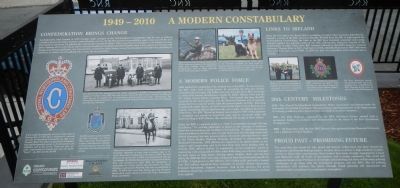
Photographed By Barry Swackhamer, June 22, 2014
4. 1949-2010 A Modern Constabulary panel
Captions: (left side) It was under the leadership of Chief of Police John R. Browne that, in 1979, Queen Elizabeth II conferred upon the Newfoundland Constabulary the right to use the prefix “Royal.” The citation recognized the Constabularyís long and distinguished service to Newfoundland and Labrador, and to the Crown. There are only two police organizations in Canada who carry the prefix “Royal” - the RNC and RCMP.; The RNC shoulder patch recognizes the RNCís heritage: The Pitcher Plant represents Newfoundland; a Spruce twig represents Labrador; and Irish harp represents the long connection with the Irish policing system.; The Motorcycle Unit, introduced in the 1940s, comprised a number of motorcycles especially designed for police work. The unit soon became one of the RNCís more valuable and effective tools, playing an integral role in summertime ground patrol and traffic enforcement. The motorcycles show in the above image are obviously modern vehicles for their time and equipped with the latest features.; Inspector General John McCowen looked stately in his uniform on horseback. Policemen on horse were a common sight in St. Johnís from their introduction to the force in 1873. The unit grew to ten horses but in 1894 was incorporated with the Fire Brigade. By 1922 the Mounted Unit re-integrated with the RNC and remained so until 1951. In recognition of superiority for crowd control and advantages for public relations, a permanent Mounted Unit was re-established in 2003. In 2010 there were four horses, all of the Percheron breed which stands almost ten feet tall; Vince, Townshend, Fraize, and Dobbin.; (center, top) The members of the Technical Rescue Unit (TRU) underwent training so that specialized skills were available when needed for circumstances such as requiring rescue from steep slopes or cliffs.; The Canine Unit, established in the 1980s, added to the resources available for such needs as tracking missing persons, and searching for lost children. German Shepherd, ĎSamí, was the first recruit for the unit and proved his worth.; (right side) In an international ceremony, in 2005, the RNC and the Republic of Irelandís Garde Siachana na hEirann exchanged colours in recognition of their historic policing links.; A new Service Patch was designed in 2002, reflecting the RNCís Irish heritage in a wreath of shamrocks, and the words “Blianta Seibhise”, Gaelic for “Years of Service”.; The RNC Historical Society was formed in 1987 and in the ensuing years established the RNC Museum in the foyer of the Fort Townshend Headquarters.
ca. 1757 - Governor Richard Edwards instructed constables to carry their staves to signify they were on duty. A stave was a carved wooden staff which was a official implement of the office of a law enforcement officier.
1786 - Some Irishmen living in Placentia rioted and overpowered the local constables. The rioters took the constableís staves from them, in an act of extreme defiance against the Crown.
1824 - Naval Surrogate Courts were abolished and towns were permitted to make their won by-laws. The following year, in a re-vamping of the Circuit Court System, Naval Officiers lost their legal powers.
1825 - For the first time Constables were required to wear a police uniform: blue coats with buttons embossed with a crown and “GR”, red waistcoats, and a hat with a cockade in it. (No depiction of this uniform appears to exist).
1832 - In this year when Newfoundland was granted Representative Government, constables were patrolling the streets of St. Johnís between 8 am and 11pm, and the salaries of magistrats were taken out of general revenues.
1848 - A police night watch was established in St. Johnís, and there were 57 constables policing in other communities across the island.
A significant development for the constabulary occurred in 1870 when England withdrew its Garrison from Newfoundland. This left the constabulary with no trained support for periodic back-up and enforcement, and Fort Townsend was vacated. Rather than having a negative impact, this opened the door for building on the firm footing for the constabulary force created under the inspired leadership of Timothy Mitchell in the 1840s. It was an opportune time for the heightened presence of a constabulary comprised of trained constables who were on duty in the community as full-time personnel. And the availability of the facilities at Fort Townsend gave the constabulary a headquarters fitting to their needs.
Panel 2:
The British Garrison withdrew from Newfoundland in 1870. In the following year Thomas Foley, a senior officier from the Royal Irish Constabulary, was appointed Inspector and General Superintendent of Police, and work began in earnest to give the Newfoundland Constabulary legal standing. In 1872 the Legislature passed An Act to Organize and Maintain an Efficient Constabulary Force, and for the Appointment of Special Constables in this Colony. The name of the force was “Constabulary Force of Newfoundland. The Constabulary retained policing responsibilities for the entire island, with headquarters in St. Johnís, at Fort Townsend, which had been left vacant by the Garrison.
Foley effectively re-organized the force and expanded its manpower by advertising for recruits in the May 16, 1871, edition of the local newspaper, Royal Gazette. Foley died unexpectedly in 1873, but his two successors carried through the tradition of being recruited from the RIC: Paul Carty (served 1873-1895) and John McCowen (served 1871-1908: as Governor of the Newfoundland Penitentiary 1879-1895; as Inspector General 1895-1908). By 188- the Constabulary had over 100 men, over half of whom served outside St. Johnís (the 1884 census put the population of Newfoundland at 193,124). The Constabulary was now an established police force, exhibiting professionalism and high standards, and as the only police force in the country, had a huge role to play in the modern development of Newfoundland. In 1909 John Sullivan became the first Newfoundland-born Commanding Officier of the Constabulary.
1883 - A sectarian riot erupted in Harbour Grace on Boxing Day, when Roman Catholics were offended by the parade of the Protestant Loyal Orange Association. The “Harbour Grace Affray”, as it was called, resulted in 5 deaths, and numerous injuries and arrests.
1895 - Under new legislation enacted July 4, three Fire Stations were opened, due largely to the work of Inspector John McCowen, who had in March been named Inspector General and Fire Chief. McCowen had worked on the Fire Relief Committee following the Great Fire of 1892, which had destroyed much of St. Johnís, and understood the need for improved fire protection.
1914 - Thirteen members of the Constabulary enlisted in WWI, three of whom made the “supreme sacrifice”.
1923 - Constabulary members were sent to Labrador, where gold was thought to have been discovered. These officiers were referred to as the “Gold Coast Police”, but when the gold discovery turned out to be false, the Constabulary withdrew from Labrador after just one year.
1932 - The poor economic conditions on the island precipitated a riot against the government outside the Colonial Building. Two members of the force were hospitalized and others hurt. When the mood of the demonstration did not improve in ensuing days, a back-up reserve force of over 100 men was sworn in. This reserve force remained available until 1938.
1934 - The Constabulary returned to Labrador to serve the area, until political decisions that same year resulted in their withdrawing from
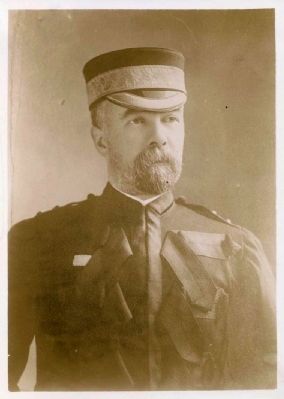
8. John R. McCowen, J.P.
Photo (pre-1908) courtesy of the Newfoundland and Labrador Provincial Archives.
John Roche McCowen (1844-1908), policeman and administrator; member of Terra Nova Constabulary (1871); governor, Newfoundland Penitentiary (1879), chairman of Board of Fire Commissioners; Inspector-General, Newfoundland Constabulary (1895). - Newfoundland and Labrador Provincial Archives.
John Roche McCowen (1844-1908), policeman and administrator; member of Terra Nova Constabulary (1871); governor, Newfoundland Penitentiary (1879), chairman of Board of Fire Commissioners; Inspector-General, Newfoundland Constabulary (1895). - Newfoundland and Labrador Provincial Archives.
1937 - Eight members of the Newfoundland Constabulary were chosen to accompany a contingent of Great War Veterans at the coronation of King George VI at Westminster Abbey in London. The officers were astounded at the welcome they received in England.
1941 - The Assistance Chief of Police and 74 Constables were sent to Buchans to help defuse labour unrest between the Buchans Mining Co. and the minerís union. The Constables delivered back-to-work orders to the miners, while a tribunal negotiated selected changes. Despite disappointment among the miners, peace was largely maintained.
Newfoundland played an important role in the Allied war effort on the home front during WWII. Four merchant ships were sunk off Bell Island by German submarines, with significant loss of life. The entrance to St. Johnís Harbour was hit by submarine torpedoes in an effort to prevent critical supplies from reaching war-torn Europe on merchant ships crossing the Atlantic in Allied convoys. The Constabulary investigated suspected espionage and sabotage, and not the least, dealt with the influx of thousands of servicemen from three nations: the United States, Canada and England.
To meet these
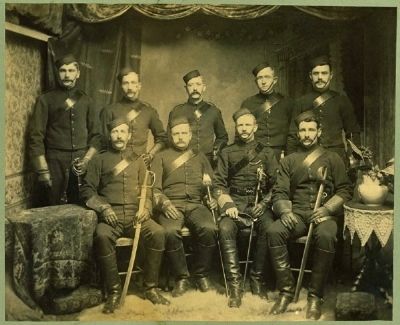
Photographed By James Vey, 1890
9. Newfoundland Constabulary Mounted Force
Photo courtesy of the Newfoundland and Labrador Provincial Archives.
Standing, l-r: Nathaniel Andrews, Archibald Gardner, Michael Savage, Patrick McDermott, John Byrne. Seated, l-r: Patrick Kane, William Collins, John Squires (Head Constable in Charge), Stephen Noseworthy.
Standing, l-r: Nathaniel Andrews, Archibald Gardner, Michael Savage, Patrick McDermott, John Byrne. Seated, l-r: Patrick Kane, William Collins, John Squires (Head Constable in Charge), Stephen Noseworthy.
Panel 3:
Confederation with Canada in 1949 brought major changes to the Newfoundland Constabulary and its role in policing Canadaís newest province. Canadaís national police service, the RCMP assumed responsibility, under contract with the new Provincial Government, for policing the communities outside St. Johnís. This caused the Constabulary to close down its many police stations all over the island, and to relocate its affected members and their families back to the capital city. Despite this change in policing jurisdiction, the Constabulary retained its police status across Newfoundland and Labrador, including its authority to enforce Newfoundland laws across the new province.
1980 marked the beginning of the modern era of the RNC. It was the year the RNC made local policing history by accepting the first five female constables into its ranks. The 1980s were also the start of the RNC returning to some of its former jurisdictions outside St. Johnís (Mount Peal and NE Avalon. Corner Brook, Labrador West). Also around this time the RNC received its first dress uniform, and the Mounted Division was re-installed, giving the force a special profile with the general public. In 1999, following considerable public debate, the RNC received the right to carry firearms as a routine, something officies had done only on occasion throughout the history of the force. The RNC Historical Society was created in 1987 with a mandate to recognize and record an important past, and to encourage pride and understanding in RNC officiers; this monument site is part of those efforts.
Today, the RNCís corporate mantra is “Safer Communities through Policing Excellence.” Its policing philosophy is based on the concept of evidence-based decision-making and intelligence-led policing. To achieve continuing professionalism in the force, new recruits must have not only high moral and ethical character, but also post-secondary education allowing them to enroll in the Police Studies Diploma Program, developed in partnership with Memorial University. RNC officiers deliver 13 community service programs, aimed at connecting with young and old alike while delivering preventative messages on such topics as drug abuse, driving safety, identity theft, and internet safety. By 2009 the RNC had come a long way from the initial policing efforts of 1729: it had grown to 383 officiers, 142 civilian staff, and with a budget over $45 million, operated three branches of service (Patrol Operations, Criminal Operations, Support Services). And in the process, the proud traditions of policing, rooted in the Irish system of the 16th century, continue to be upheld.
1970 - The (Royal) Newfoundland Constabulary Police Association was formed under the leadership of Constable Tom Fraize. The association contributed greatly to the improvement of working conditions and related matters on behalf of its police members.
1987 - The RNC Museum, supported by the RNC Historical Society, opened with a permanent display of artefacts and interpretation in the foyer of the Fort Townshend Headquarters.
2005 - On September 2nd, the first RNC Recruit Class graduated from Memorial University with a Diploma in Police Studies.
The road that lies ahead for this proud and historic police force has been cleared by competent and forward-looking leaders. In their drive to deliver a high standard of police service to their entire constituency, these leaders have been strongly supported by a loyal and dedicated staff, all levels of government, and a caring community. The social and economic future of out Province is very bright and promising, but there will be many policing challenges to go along with the anticipated progress, and the RNC, like its policing forefathers, will embrace the future through sound planning and operational and administrative excellence in a community atmosphere.
Erected by Royal Newfoundland Constabulary Association.
Topics. This historical marker is listed in this topic list: Government & Politics. A significant historical month for this entry is May 1950.
Location. 47° 33.886′ N, 52° 42.584′ W. Marker is in St. John's, Newfoundland and Labrador, in Avalon Peninsula, Newfoundland. Marker is at the intersection of Queens Road and Gower Street, in the median on Queens Road. Touch for map. Marker is at or near this postal address: 80 Queens Road, St John's NL A1C, Canada. Touch for directions.
Other nearby markers. At least 8 other markers are within walking distance of this marker. St. John the Baptist Anglican Cathedral (about 90 meters away, measured in a direct line); Masonic Temple (about 180 meters away); St. Johnís Court House (about 210 meters away); William Carson (about 210 meters away); Former Bank of British North America (approx. 0.3 kilometers away); Bank of British North America (approx. 0.3 kilometers away); OíDwyer Block (approx. 0.3 kilometers away); Thompson Building (approx. 0.3 kilometers away). Touch for a list and map of all markers in St. John's.
More about this marker. This monument is in a small triangular park bound by Queens Road, Long's Hill and Gower Street.
Regarding (Royal Newfoundland Constabulary Monument). The term “Constabulary” was used to describe a police organization that enforced law on a territorial basis. Its members were deployed in small groups, its officiers were armed, and it maintained its own mounted section. This clearly depicted the Newfoundland Constabulary in the 1800s and early 1900s.
Also see . . . Royal Newfoundland Constabulary - Wikipedia. The Royal Newfoundland Constabulary (RNC) is a police force in the Canadian province of Newfoundland and Labrador. It provides policing to the communities of St. John's and the Northeast Avalon Peninsula, Corner Brook, Churchill Falls, Labrador City, and Wabush. (Submitted on November 25, 2014, by Barry Swackhamer of Brentwood, California.)
Credits. This page was last revised on June 16, 2016. It was originally submitted on November 25, 2014, by Barry Swackhamer of Brentwood, California. This page has been viewed 1,024 times since then and 40 times this year. Photos: 1, 2, 3, 4, 5, 6, 7. submitted on November 25, 2014, by Barry Swackhamer of Brentwood, California. 8, 9. submitted on November 27, 2014. • Andrew Ruppenstein was the editor who published this page.

